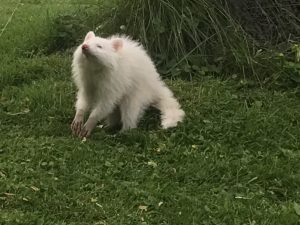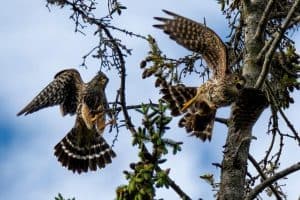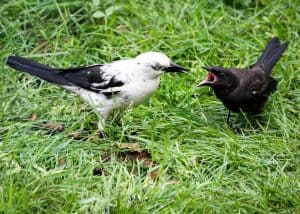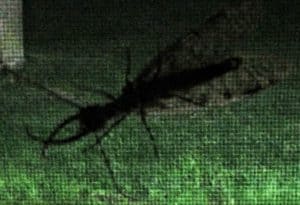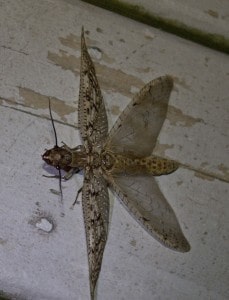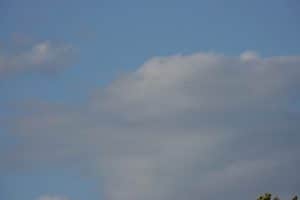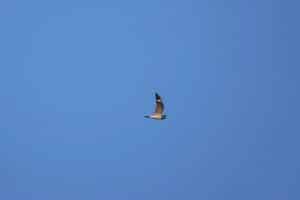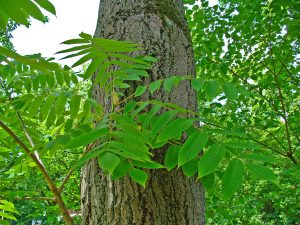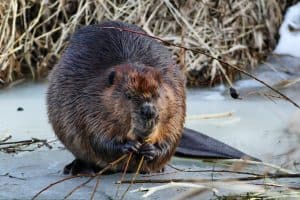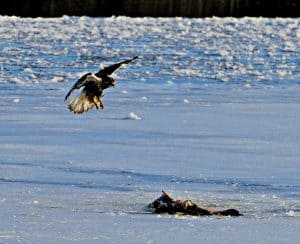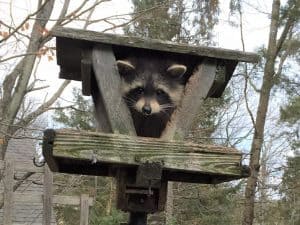This week, I’d like to share more nature sightings from the past year that readers have shared with me. I am always pleased to learn about what people are seeing and to try to answer nature-related questions. To stay abreast of the latest sightings in Peterborough and the Kawarthas, please visit my website at drewmonkman.com and click on the Sightings tab. You will also find information relating to climate change in the Kawarthas.
July
· My neighbour, Ed Kloosterman, showed me some pictures of an albino raccoon that ran across his backyard on the edge of Little Lake in early July. At first it was hard to make out just what the creature was! Ken Brown, Engleburn Avenue
· Merlins are using a tree just off our Reid Street balcony in Peterborough to exchange songbirds they’ve caught. We’ve been seeing them do this five or six times a day. Quite a spectacle, to say the least. Mike Fought
· On July 12, a leucistic (i.e., lacking normal pigmentation) common grackle was feeding its fledgling in my backyard. It hung around the feeder most of the day. Sharon Watson, County Road 36, Lindsay.
· We have now protected three painted turtle nests. At least two of these nests definitely have eggs as a skunk has been trying to dig around the edge. We also found a fourth nest, which had been dug out. Eggs shells were lying around the hole, along with four tiny, dead painted turtles, all rather desiccated. This must have been a nest from last year, since the hatchlings overwinter in the nest after they emerge from the eggs in fall. Stephenie and Peter Armstrong, Warsaw
· The other day, we found an enormous bug – probably five inches in length – stuck to the patio screen. We’d never seen an insect this big in our lives. I gently swept it off the screen and it landed on the patio. The wing cover was silver and blended well with the patio bricks. Any clue what this creature is? Gord Young, Armour Road
(Note: Gord’s visitor was a male dobsonfly. Males have huge mandibles (pincers), which are used only in competition for females. In the aquatic larval stage, they’re called hellgrammites and are a popular fish bait. D.M.)
August
· Regarding my efforts to re-establish near-extinct American chestnut trees, I have lots of good news. First, all of the seedlings that I started in the spring have survived and seem to be thriving. Second, for the first time, all three of my most mature trees produced catkins this spring. I’m hopeful I’ll be able to harvest many more viable seeds this autumn than last. Third, and maybe most important of all, I discovered an American chestnut sapling that must be at least five years old and only metres away from the three original trees that I planted. Given its height (about a metre and a half) I surmise that it was planted by squirrels in the first year that the trees produced nuts. This is the proof I needed that the trees could self-seed. Michael Doran, Kinmount
· On the evening of August 29, Tim Dyson & I counted migrating common nighthawks from Back Dam Park near Warsaw. We tallied 133 birds, with one “flock” comprising at least 48. Quite a sight! Tim had already had several evenings in late August with more than 100 nighthawks. Nighthawks have declined by 68% since 1970, but the species still seems to be quite common in suitable boreal forests habitats.
· People continued to report red-headed woodpeckers in the Trent University Nature Area. On August 11, Matt Mair saw three individuals at once in the silver maple swamp off the blue trail. They were unmistakable with their fully red heads and black wings with a white patch. The birds were first seen in June.
September
· We have several endangered butternut trees on our farm. There were no nuts last year, but this year the crop is abundant. As for wild grape, the amount of fruit is overwhelming. We’ve also seen more monarchs this year than ever before. Darienne McAuley, Bland Line
· On August 31, I came across a scene that intrigued me. Caterpillars of both the monarch butterfly and milkweed tussock moth were feeding on the same leaf. At times they seemed to face each other in an aggressive fashion but then just turned away and continued to eat. Gwen McMullen, Warsaw
October
· A leucistic “Halloween ghost robin” was eating berries in our yard today. Fred and Marg Forster, Keene
· On October 6, an eastern towhee spent the entire day in our yard. It was on the ground but did not go up onto the feeders. Carol and Bruce Forsythe
· A number of people reported interesting birds in the Lakefield area. On October 22, Chris Risley had two mute swans at the Lakefield Marsh. At the same time, a rare female canvasback duck was at the Lakefield-Sewage Lagoons.
November
· I found a snowy owl this week at the north end of Post Road, just east of Lindsay. Then, on November 26, I was able to get good pictures of two beavers along Hooton Drive where it crosses the Cavan Swamp, just west of Peterborough. Carl Welbourn
· On November 21, at around 5:30 pm, I was driving up to Lakefield along County Road 32 and was surprised to see dozens – or perhaps even hundreds – of frogs hopping across the road towards the river. It was raining lightly, and I know that frogs often move on nights like that. However, given the late date, the long period of frigid weather we’d had, and the fact that it was only 3 C, I was quite surprised to see this! Carrie Sadowski (Note: I’m not aware of frogs “migrating” towards the river at such a late date and especially not after such a long period of cold, with temperatures as low as -20 C. I imagine most of them were leopard frogs, which overwinter on the bottom of large bodies of water like the Otonabee River. I wonder if they got “caught” by the sudden arrival of cold whether before being able to make it to the river. They do feed in upland locations during the late summer and fall. D.M.)
· On November 30, I had gone up to the north part of the field here to move some rocks. Just as I got there, I looked up and saw a lovely adult golden eagle soaring right above me. High in the background, there was an upper tangent arc caused by the sun lighting up the hexagonal ice crystals of the cirrus cloud deck. Wow! A golden eagle with a vivid rainbow backdrop! Tim Dyson, Douro 1st Line
· My granddaughter, Grace Mackie, observed an opossum running along Oriole Boulevard during the week of November 16. I knew that opossums had made it to Toronto but did not know they were in Peterborough. I am intrigued by how they would survive our winters – under decks, garages, wood duck tree nests? Perce Powles
(Note: Virginia opossums are definitely present in the Kawarthas but still relatively uncommon. They probably do take advantage of all the shelters that Perce mentions. In early December, Andrea White saw an opossum on Edmison Drive, not far from Oriole Boulevard. D.M.)
December
· On December 3, I was able to get some pictures of a rough-legged hawk dining on a carp at Lock 25 on the Otonabee River. Carl Welbourn
· Throughout November I had three young raccoons coming to my yard and eating birdseed. As of mid-December, two are still around. I managed to get a picture of one peering at me through the feeder. Pretty cute! Bet Curry
· On the morning of December 15, I watched four river otters and three bald eagles on the Trent River in Campbellford. I was able to get a picture of a young eagle flying in and stealing a catfish that one of the otters had caught and brought up onto the ice. Donald Munro, Campbellford
What to watch for this week
Identifying and interpreting mammal tracks is a fascinating pastime and adds a great deal to a winter outing. Don McLeod, a local naturalist with a special interest in tracks, has detailed pictures of the tracks of local mammals on his wonderful blog at https://www.donaldmcleod.com/Keyword-Galleries/Mammal-Tracks
Climate Crisis Update
The COP25 climate talks wrapped up in Madrid on December 16. Here are six takeaways. 1. There was no agreement on a global system of carbon markets and offsets. The issue is back on the agenda for climate talks next year. 2. There was agreement on a call to boost emissions reductions. 3. Finance remains a major sticking point as developed nations watered down any calls for new financial support for those nations most vulnerable to climate change. 4. The divide between old emitters (e.g., the U.S) and new emitters (e.g., China, India and Brazil) over the responsibility to cut emissions remains. 5. There is a widening gulf between the expectations of climate activists – especially youth – and climate negotiators. “The climate talks are over for this year, but citizen activism is not,” May Boeve, the executive director of grassroots movement 350.org, said Sunday, pledging “to keep marching and disrupting and pressuring our politicians.” 6. There is a sense that global climate efforts are in a political and procedural crisis. Jennifer Morgan, Greenpeace International’s director, said that “governments need to completely rethink how they do this, because the outcome of COP25 is totally unacceptable.” The bottom line is that for most corporate and political leaders in the world, there is still no sense that we’re in the midst of a climate emergency.
The 26th session of the Conference of the Parties (COP 26) will take place from 9-19 November 2020, in Glasgow, UK. It will be the most important climate summit since the landmark Paris Agreement was agreed at COP21.
